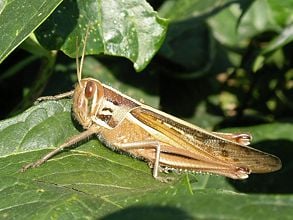Orthoptera
| Orthoptera | ||||||||||||||
|---|---|---|---|---|---|---|---|---|---|---|---|---|---|---|
 Patanga japonica
| ||||||||||||||
| Scientific classification | ||||||||||||||
| ||||||||||||||
|
The Orthoptera ("Straight Wings") are an order of insects with incomplete metamorphosis, including the grasshoppers, crickets and locusts. Many insects in this order produce sound (known as a "stridulation") by rubbing their wings against each other or their legs, the wings or legs containing rows of corrugated bumps. Their ears, located in the front legs, are interconnected in such a way that they are able to locate each other by sound.
Characteristics
Orthopterans have two pairs of wings; the forewings are narrower than the hind wings and hardened at the base. They are held overlapping the abdomen at rest. The hind wing is membranous and held folded fan-like under the forewings when at rest. They have mandibulate mouthparts, large compound eyes, antennae length varies with species. Their hind legs are enlarged for jumping.
Life cycle
Orthopterans develop by incomplete metamorphosis. Most orthopterans lay their eggs in the ground or on vegetation. The eggs hatch and the young nymphs resemble adults but lack wings and at this stage are often called hoppers. Through successive moults the nymphs develop wings buds until their final moult into a mature adult with fully developed wings.
The number of moults varies between species; growth is also very variable and may take a few weeks to some months depending on food availability and weather conditions.
Orthoptera as food
The Orthoptera are the only insects considered kosher in Judaism. Although the Bible may be read as stating that all Orthoptera are kosher except those, such as the mole cricket, that do not jump, halakhic authorities state that only four species known in Yemen are kosher.
Taxonomy note
Note that the cricket suborder Ensifera will probably be given its own order soon, the Grylloptera. The Orthopterists' Society also recently (December 2005) decided upon a major change in the classificatory organization of the Ensifera.
See also
- List of orthoptera recorded in Britain
External links
- Orthoptera Species File Online
- Orthoptera Image Gallery (Iowa State University Entomology Department)
- Australian Plague Locust Commission
- The Orthopterists' Society
Credits
New World Encyclopedia writers and editors rewrote and completed the Wikipedia article in accordance with New World Encyclopedia standards. This article abides by terms of the Creative Commons CC-by-sa 3.0 License (CC-by-sa), which may be used and disseminated with proper attribution. Credit is due under the terms of this license that can reference both the New World Encyclopedia contributors and the selfless volunteer contributors of the Wikimedia Foundation. To cite this article click here for a list of acceptable citing formats.The history of earlier contributions by wikipedians is accessible to researchers here:
The history of this article since it was imported to New World Encyclopedia:
Note: Some restrictions may apply to use of individual images which are separately licensed.